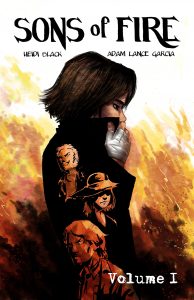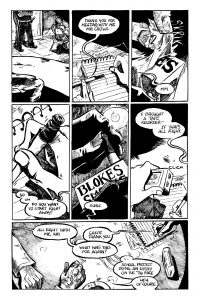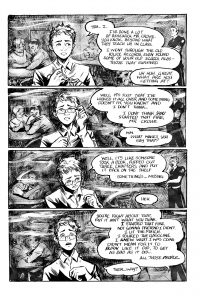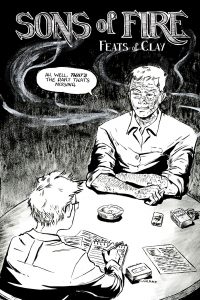Written by: Adam Lance Garcia
Art by: Heidi Black
Available now through Comixology, Kindle and Amazon.
Fun story – The Pullbox Crew was at C2E2 in Chicago last month, checking out new comics, taking names, talking to people – the normal things you do at a convention when you’re a comics review and pop culture website. We’d been social with an eclectic mix of folks on Friday night, and the next day on the con floor we all happened to be together when our hostess from the night before thrust a paperback towards us. “Someone write a review of this,” she said. “Sure,” I said and took it from her. The description on the back sounded interesting, so I put it in my bag and took it home.
Sons of Fire is not at all what I thought it would be. It begins with our protagonist, Jacob Crowe, being interviewed by a young man writing a paper for a college journalism assignment. The boy wants to know more about a fire that happened many years ago, burning down the house of Jacob’s mother and her new husband, killing a football star and his girlfriend. The fire ended up spreading quickly and burning down half the town. Jacob was convicted, and is now serving time. This isn’t about the convict, though. This was about the kid who survived a fire before – who was immobile when his brother needed him and who watched his father burn. As stories of the past are told they become more fantastic, leading to the cliffhanger where Jacob finds out that even the popular kids have parts of themselves that they hide.
Garcia’s story of kids trying to find their own way in the early 70’s feels REAL. These kids will never be featured on Highschool Musical or nor are they pretty enough to be students at Riverdale. These kids aren’t demons, just the normal cruel human beings that everyone was as a teenager. Even the nice ones have an edge to them. From the sporty kids to the druggies to the marching band, every one of these kids existed in my high school. Garcia breathed life into each pre-cancerous lung, and they spoke like they lived this life yesterday.
Black’s black and white art is gritty and honest. The faces are fresh and yet you can see every emotion – you never wonder how anyone is feeling. Her use of darkness portrays the many ways people hide things – the smoke from the fire obscuring suffering, the shade under the bleachers hiding cruelty and bullying, the night overshadowing murderous intent, even the opening scene in the visitor’s room is murky with smoke to indicate the mystery revelation. It’s all there for you.
The whole story is a raw, emotional roller coaster. Even those who haven’t lost family in such a devastating way can relate to the deep sorrow of the characters and how they cope. If you didn’t buy this book when it first came out, now is the time. I am really hopeful that they won’t give up until the story is complete. It’s a tale that sticks with you.



